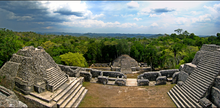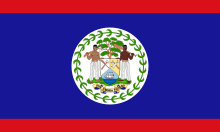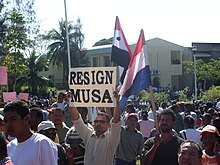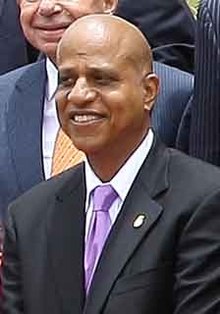History of Belize
The history of Belize describes the history of the state of Belize in Central America , which has been independent since 1981, as well as the direct history of this state as a British colony or zone of influence from the late 18th century, the previous 300 years of Spanish domination and, in a brief overview, the history of the Indian Maya cultures on the territory of Belize before the arrival of the Europeans.
Mayan high culture
See also main article Maya
Since around 2500 BC The region of what is now Belize was settled by the Maya , whose descendants still live in the country today. The basic institutions of the high culture of the Maya developed between this time and 250 AD. The center of the Maya culture shifted several times in the course of the 2000 years of its existence, in the classical period was the city of Caracol in today's Belize, the ruins of which are still impressive today are one of those centers. Significant archaeological finds have been made in Cuello ( Orange Walk District ) for the early period . During the "classical period" of the Maya civilization (around 250 to 900), cultural centers also emerged in Altun Ha , Xunantunich , Cahal Pech , Lamanai , Lubaantun and El Pilar . In the late classical period, around 400,000 people are believed to have lived in what is now Belize. Around the year 900 there was an extensive collapse of the Maya civilization, the causes of which are still not fully understood.
Although people continued to live in places like Altún Ha, Xunantunich or Lamanai, the population figures had clearly declined and these places had lost their importance as powerful ceremonial and political centers. The first European "explorers" continued to meet the Mayan population when they arrived on the coast of Belize, but their cultural and political institutions had already passed their peak.
Spanish sovereignty
At the beginning of the 16th century, the ships of Martín Alonso Pinzón and Juan Díaz de Solís , captains of Christopher Columbus , reached the coasts of Belize, and in 1525 the conquistador Hernán Cortés passed through southwestern Belize on his way to conquer the Yucatan . In the course of the 16th century, the Spaniards “pacified” the region of what is now Belize, that is, they did not establish permanent rule, but drove large parts of the coastal population into the highlands. In addition to the military use of the Spanish, it was epidemics such as the smallpox they brought in that decimated the population and broke the organized resistance. The city of Tipu in central Belize was one of the centers of resistance against the Spaniards. In the 17th century it only had to endure Spanish occupation for a short time and was largely able to maintain its independence due to the great distance from the center of colonial power in Yucatan.
The country was of interest to the Europeans because of the wood of the tropical forests, but due to the persistent resistance of the inhabitants and the largely impassable coasts and mountain regions in the hinterland, they concentrated their activities more on the areas of today's countries Mexico and Honduras , where especially also Gold and silver were to be looted.
Around 1700 the tide turned and in 1707 the Spaniards abducted several residents of Tipu and other places in Belize into slavery. A civil war ensued in the region between the Mozul Maya of southern Belize, who continued to offer open resistance to the Spanish, and the Maya of Tipu, who tried to come to terms with them. In 1708 the Spaniards, with the support of Tipu soldiers, destroyed the Mozul Maya armed forces and then relocated the last inhabitants of Tipu to Lake Petén Itzá . From 1729 the Spaniards finally withdrew from Belize without giving up their claim to ownership. In the meantime, however, the residents had grown up a new enemy in the form of British pirates .
Beginning of British influence and Spanish-British rivalry
The coasts of Belize offered an ideal retreat for British pirates , the so-called buccaneers , who started their raids against the Spanish fleets from there. On land, they have also been cutting logwood , a type of tree that was used as a dye, since the middle of the 17th century . According to a legend, one of these buccaneers, Peter Wallace called "Ballis", was named after the Belize River in 1638 and thus the namesake of the later state of Belize.
It wasn't until 1670 that piracy stopped when Britain and Spain signed a treaty in Madrid to end the practice. The baymen , as the pirates or privateers were called because they were mainly in the Gulf ( Bay ) of Honduras , were forced to look for other sources of income and found them in the logwood trade. During the 17th and 18th centuries, the colony was attacked several times by neighboring Spanish settlers and troops because of the economic rivalry and Spanish claims to the area. In 1763, the Treaty of Paris gave the British settlers from Spain permission to extract timber in a certain part of Belize. However, the treaty failed to resolve the conflict between Spain and England. In a Spanish attack on September 15, 1779, Belize City was destroyed and many prisoners were taken to Havana . In 1783, with the Treaty of Versailles, the settlers were again given permission to use wood. After the outbreak of another colonial war from 1796, the number of Spanish attacks rose again. With the support of the Royal Navy , the British settlers defeated a Spanish flotilla under the command of the Governor General of Yucatán in the Battle of St. George's Caye on September 10, 1798 . This Spanish attack with 30 ships, 500 sailors and 2,000 soldiers marks the last attempt by Spain to wrest control of the area from the British.
Slavery in the 18th and early 19th centuries
For around a hundred years, the timber industry remained the main source of income for British settlers in the region. Slavery soon went hand in hand with forest work . From the 18th century onwards, European settlers began using African slaves for this hard work. However, Belize was still formally under Spanish rule and the treaties forbade the British settlers to create (labor-intensive) plantations . However, the number of slaves in the country increased when logging was superseded by the extraction of mahogany . Until 1790, the share of slave labor in the total registered population, without the Maya, which was not counted, was around 75%. Many black slaves escaped to Guatemala and Honduras during the 18th century.
It was not until 1833 that slavery was abolished in the British Empire as a result of the industrial revolution that created new relations of production. While slave owners were compensated for the loss of their "property", meaning the freed slaves, the latter received neither compensation nor were they allowed to acquire land. The British cushioned the effects of the abolition of slavery with a transition period of five years. This phase was called "apprenticeship" , through which the former slave owners should keep control over the former slaves. Even after this period, the actual balance of power between black and white changed little.
Immigration of the Garifuna
In 1802 the first 150 Garifuna reached Belize. The Garifuna were of mixed African, Arawak and Carib ancestry and originally lived on the island of St. Vincent , which was taken over by the British by the Treaty of Versailles in 1783 . Conflicts soon arose there between the slave-holding British and the free-living Garifuna, who found support in the French, who were competing with Great Britain. The French and Garifuna lost this dispute and in 1796 the British forced 5000 Garifuna to an island off Honduras. Only 2500 of them survived this trip. From here, with Spanish approval, they reached various places on the mainland coast, including Belize. After a civil war in Honduras, in which the Garifuna were on the side of the losers, several of them immigrated again to Belize, where they now make up about 6% of the population.
The British discriminated against the Garifuna in a similar way to the Maya, granting them reservations in 1872 and denying them the right to purchase land.
British self-government before the colony was established
The rest of the mainland of Central America was under Spanish colonial rule until the middle of the 19th century , with the exception of the British Mosquito Coast in what is now Nicaragua , whose history was similar to that of Belizes. Although the Spaniards were never really able to exercise their sovereignty over Belize and gradually granted the British settlers more and more extensive control over their settlement area, the British avoided a formal annexation of Belize for a long time in order not to provoke the Spaniards. The settlers therefore largely organized their community themselves. From 1738 they elected an assembly that could pass laws. In 1765 these self-imposed laws and regulations were codified and expanded into a set of rules called Burnaby's Code . In the London Agreement of 1786, the British allowed settlers to cut and export tropical timbers, but not to build fortifications, form any form of government, or practice plantation farming. However, these agreements were systematically broken on all points by the settlers.
Spain retained formal rule over Belize until September 10, 1798, when the Battle of St. George's Caye saw the decisive military defeat of the Spanish against the British. Now the country was under British rule, without much change in the largely independent and self-determined life of the settlers.
1850–1871: transition period and definition of boundaries
In 1854, Britain took a major step towards establishing formal colonial structures in the settler colony with Belize having a constitution and a legislative assembly. The 18 members of this congregation were required to have a fixed minimum net worth of £ 400 and a minimum annual income. It was clearly a representative of the rich settler families. The British superintendent could also appoint three of the members, call or dissolve the meeting at any time, and give or refuse to approve the laws at will. This made the Colonial Office in London the true ruler of the colony.
The neighboring areas of Belize had gained independence from Spain since the 1820s, and at the same time a new power had emerged in Central America with the USA . Considerations about building a canal between the Caribbean and the Pacific led to the so-called Clayton-Bulwer Treaty between Great Britain and the USA in 1850 , in which both sides undertook to refrain from any attempt to colonize any part of Central America. However, the treaty left open whether it also meant colonized areas such as Belize. In 1853, in line with the Monroe Doctrine , the United States asked Great Britain to leave Belize. In 1856, the USA recognized British rule over Belize, and the Sarstoon River, mentioned in the later national anthem of Belize , was set as the southern border with the newly formed neighboring state of Guatemala . Another treaty in 1859 described the western border of Belize, with which the territorial dispute with Guatemala was only temporarily settled. The course of the border with Mexico in the north remained unclear .
Caste war and Mayan resistance
From 1847 to 1901 there was a so-called caste war on the neighboring Yucatán Peninsula (Mexico) between the original inhabitants, the Maya, and the Spanish-born upper class. The British residents of British Honduras supplied the rebellious Maya with weapons and ammunition, which opened up a welcome source of income for them. The country became a target for refugees as the war progressed: first from members of the Mexican upper class who fled the insurgents, and later, when they regained control, Maya. As farmers, the latter had a great influence on the development of the northern provinces of the country with their agricultural skills.
As early as the end of the 18th century, the penetration of British loggers inland had led to decisive resistance from the Mayans living there. These conflicts escalated in 1866 when a Mayan group led by Marcos Canul attacked a mahogany felling camp. British troops who moved against the rebellious Mayas shortly afterwards were defeated by Canul's forces. The following year, the British succeeded in driving the rebellious Mayans out of their villages. But in 1870 they fought back and occupied the city of Corozal . A failed Mayan attack on Orange Walk on August 31, 1872, in which Marcos Canul fell, marks the last serious military attack on the British colony.
British Honduras
British Honduras Crown Colony
The inability of the two white interest groups in Belize - the white plantation owners, who were directly threatened by the insurgent Maya, and the Belize City merchants - to agree on the cost of the measures against the insurgent Mayans led members of the Legislative Assembly eventually renounced their independence and asked for the status of a British Crown Colony . In 1871, what would later become Belize officially received colonial status and was declared the British Crown Colony of British Honduras . The old upper class of local landowners was increasingly being replaced by British corporations, and the British Honduras Company soon owned roughly half of all private land holdings. By 1890, the country's economy was largely in the hands of newly arrived Scottish and German entrepreneurs.
The emergence of a civil society in the middle of the 20th century and aspirations for independence
The legislative council, the political representative of the colony, was dominated by whites well into the 20th century, although the ethnic composition of Belize was similar to that of today at the end of the 19th century: besides the whites, there were predominantly Protestant blacks, the English or English-based Creole and mostly lived in Belize City, Roman Catholic Maya and Mestizo who spoke Spanish and lived mostly in the north and west of the country, and finally the Roman Catholic Garifuna, who spoke English or Spanish and settled on the southern coast . But it was only in 1927 that at least the Creole traders gained influence in the legislative council.
At the beginning of the 20th century, resistance against the British colonial rulers grew, especially among the non-European population. Soldiers who served in the British Army during the First World War were only used in labor camps there because of their skin color, which further increased discontent. The workers in the logging camps lived in slavery-like conditions, and the Labor Act of 1883, the Masters and Servants Act , made breaking an employment contract a criminal act and lasted until 1943. When the governor's 1931 proposals refused to approve trade unions, introduce a minimum wage and health insurance, a series of demonstrations, strikes and uprisings took place from 1934 onwards, which can be seen as the birth of the modern independence movement. Unions were approved in 1941, and the General Worker's Union , registered in 1943 , soon grew into a nationwide organization supported by the nationalist People's United Party (PUP) founded in 1950 . The goals of the PUP were a. the introduction of general adult suffrage without the test of literacy, which was valid until then, a generally elected legislative council and the curtailment of the governor's rights. In 1952, the PUP, under the leadership of George Cadle Price, won the election in Belize City, although the colonial administration presented the PUP as pro- communist and pro-Guatemalan. In 1954, general elections were held for the first time without restrictions on educational level and wealth, and the PUP achieved an overwhelming victory with 66.3% of the votes and a high turnout, which represented a clear vote in favor of the country's independence.
Dispute with Guatemala as an obstacle to independence
In 1961 the "mother country" Great Britain was ready to give British Honduras independence. From 1964, British control was limited to the defense of the colony, its foreign affairs, internal security and certain public service matters. In 1973 the name British Honduras was changed to Belize in anticipation of independence. In 1978 the Belize Defense Force was established as a military.
The greatest obstacle on the way to independence, however, turned out to be the claims of neighboring Guatemala on Belize since the early 1960s. For nearly 20 years, the British and Guatemalan governments negotiated the fate of Belize with multiple interruptions. George Price rejected, among other things, the proposal to make Belize an "Associated State" of Guatemala. In November 1980, Guatemala was finally completely isolated, and the United Nations Security Council adopted Resolution 491 , which called for the independence of Belize. Without having reached an agreement with Guatemala, Belize became independent on September 21, 1981.
independence
Relations with neighboring Guatemala , however, remained problematic. Only the fact that British troops remained in Belize prevented Guatemala from taking any military action. It was not until 1992 that the Guatemalan government signed a treaty that recognized Belize's independence, but did not clarify claims to territories in the west of the country. In 1994 Great Britain withdrew its last troops from Belize, except for a few training soldiers. Negotiations have been taking place between the two countries since 2000, in which Guatemala should be given at least sea access via Belize.
In the first parliamentary elections after independence in 1984, the United Democratic Party (UDP) was victorious ; Prime Minister was Manuel Esquivel . Five years later Price took over the office of Prime Minister again, in 1993 he had to leave it to Esquivel and UDP again. Public sector layoffs and price hikes resulted in an overwhelming 1998 election victory for the People's United Party (PUP). Said W. Musa became the new prime minister. He owed his re-election in 2003 mainly to extensive infrastructure measures and the creation of living space and jobs. However, this drove up national debt, so that in 2004 the government was forced to launch an austerity program.
Belize was largely spared the wars and civil wars that other Central and South American countries went through. But unrest broke out at the beginning of 2005 due to the state budget situation and planned tax increases .
In February 2008, the PUP was replaced by a landslide victory for UDP. Acting Prime Minister is Dean Barrow , making him the country's first black Prime Minister.
Web links
- Country Studies Belize
- Silvia Pinzon, Ray Auxillou: The early history of Belize.
- The Anglo-Belize / Guatemala Territorial Issue, Janine Silvestre 1995
Individual evidence
- ↑ Stephen D. Houston, John Robertson, David Stuart: The Language of Classic Maya Inscriptions. In: Current Anthropology 41 (3), 2000, pp. 321–356 (information taken from en: History of Belize).
- ↑ a b c d e Country Studies
- ↑ Silvia Pinzon, Ray Auxillou: The early history of Belize.
- ^ Assad Shoman: XIII chapters of a history of Belize . The Angelus Press, Belize City 1995, ISBN 976-8052-19-8 , p. 84.
- ↑ Tim Merrill (ed.): Guyana and Belize. Country studies . Library of Congress Federal Research Division Corporation, Washington, 2nd ed. 1993, p. 181, ISBN 0-8444-0778-X .
- ^ The Anglo-Belize / Guatemala Territorial Issue, Janine Silvestre 1995









